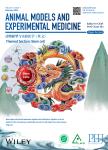LasDB: A collective database for laboratory animal strain resources
LasDB: A collective database for laboratory animal strain resources作者机构:Institute of Laboratory Animal ScienceChinese Academy of Medical Sciences(CAMS) and Comparative Medicine CenterPeking Union Medical College (PUMC) NHC Key Laboratory of Human Disease Comparative Medicine Key Laboratory of Human Diseases Animal Model State Administration of Traditional Chinese Medicine Beijing Key Laboratory for Animal Models of Emerging and Reemerging Infectious Diseases Beijing Engineering Research Center for Experimental Animal Models of Human Critical Diseases
出 版 物:《Animal Models and Experimental Medicine》 (动物模型与实验医学(英文))
年 卷 期:2018年第1卷第4期
页 面:266-271页
学科分类:0710[理学-生物学] 1001[医学-基础医学(可授医学、理学学位)] 10[医学]
基 金:the Central Research Institutes Basic Operating Grants,Grant/Award Number:DWS201512 CAMS Innovation Fund for Medical Sciences(CIFMS),Grant/Award Number:2016-I2M-2-006-03 National Major Scientific and Technological Special Project for Key Infectious Diseases,Grant/Award Number:2017ZX10304402-001
主 题:comparative medicine database laboratory animal resource strain
摘 要:Background: With the aim of establishing the most comprehensive database of laboratory animal strains, the laboratory animal strain resources database(LasDB)was constructed as a searchable online database of all laboratory animal strains,stocks and mutant embryonic stem-cell lines available worldwide, including inbred,outbred, mutant and genetically engineered strains.Methods: MySQL database software was used to construct the LasDB, offering an easy-to-use interface.Results: To date, LasDB has a collection covering data for 21 596 mouse strains,2062 rat strains, 13 monkey strains, 2 hamster strains, 5 dog strains, 5 rabbit strains and more than 50 other laboratory animal strains. LasDB will be continually improved with regular updates of new laboratory animal strains from all over the world.Conclusion: To the best of our knowledge, this is the first database that attempts to systematically integrate all available laboratory animal strain data with the aim of supporting open usage and full resource sharing.



